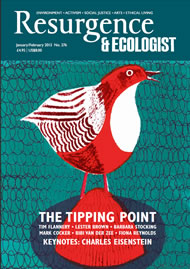Earlier this year I met Bob Gilbert, and in between talking about keeping chickens in the East End of London, he told me about the updated edition of his book The Green London Way, which was being published to coincide with the 2012 Olympics. Hearing Bob describe the circular route around London that he had first devised over 20 years ago, when the book was first published, and thinking about all the social and environmental changes that have taken place since then made me think one thing: I’m going to do it… And I did!
The Green London Way is divided into 18 walks, which together make up the 110 miles of the route, and this updated edition starts and finishes in the East End at Stratford Station (in the shadow of the Olympic Stadium), and takes us through Greenwich, Crystal Palace, Richmond and Hampstead. Although the book is written for armchair hikers as well as for active walkers, I didn’t want to just read about the ecological impact of London 2012: I wanted to see it for myself. I was not let down.
The ever-changing social and natural history are brought vividly to life via the introductory narrative at the start of each chapter. The planning is so precise that each walk begins and ends at a train station and it is possible to just follow the clearly laid-out instructions and, as you walk, concentrate on taking in everything around you: the struggles for open spaces, the scars left by war, and the latest efforts to create community are all highlighted and revealed.
I spent five days walking the Green London Way and was lucky enough to be joined by the author for two of them. Bob has been a stand-up comedian, and his wit and sense of humour shine through in the book. Stories behind the architecture and infrastructure that we walked through are told in Bob’s unique voice, and his perspective is as clear in print as it is when he speaks.
The landscape that is encountered along the Green London Way is completely different from the North Devon coast where I live, and I was taken aback to encounter animals that are commonplace at home, such as chickens, pheasants and deer, fenced off in urban zoos, the subjects of mystified onlookers. The changes in species diversity and abundance are described throughout the book and comparisons with the natural make-up of the city back in 1991 when the first edition was published are well documented too. As expected there have been some distressing changes, but there are some good-news stories too, such as the increase in numbers of the great spotted woodpecker (Dendrocopos major), the goldfinch (Carduelis carduelis) and the long-tailed tit (Aegithalos caudatus).
The beauty of this book (and the clue is in the title) is that it uncovers London’s towpaths, woodlands and commons and creates a long-distance, living network of green spaces. Each time the tarmac takes over and you are subjected to the concrete jungle, you find yourself longing for the next green portal that will take you back into what are, for me, more familiar living and breathing habitats.
Each walk is accompanied by an illustrated map by ‘the urban Wainwright’, Graham Scrivener, and with these and Gilbert’s meticulous navigation notes it is almost impossible to get lost (I only managed that feat twice, due to absent mindfulness).
The Green London Way provides a wealth of information about the plant and animal life of London, including some surprising instances of rare species. In terms of Nature, landscape and history, it is full of discoveries that will enchant any walker or reader. And by actually walking the Green London Way, I left the capital with a whole new awareness of Greater London and the challenges we face as environmentalists.








